Our shooting facility recently opened a 2,000-yard range. After doing some research, for shots greater than 1500 yards, all indications are that heavier bullets are beneficial because for extreme ranges they maintain momentum (M=KxV) so the higher the momentum the higher the retained velocity.
This project started out with a Savage 110 precision rifle in 300 PRC; however, brass choices initially were limited. I then found 300 PRC brass could be made from the 8x68s case which Norma or RWS makes and decided to go in that direction. Although since this work was conducted Lapua now makes 300 PRC brass.
Specifics:
Rifle: Savage 110 Precession 300 PRC with 20 moa rail. Initially factory barrel used followed by a Shilen select match stainless steel barrel. Factory barrel was 1:8.5 with the Shilen having 1:8 twist.
Scope: Burris 8.5x40x50 FClass
Rings: Burris signature tactical with inserts set to 20 moa
Brass: RWS 8x68s case fireformed to 300 PRC
Bullets: Hornaday 250 grain A tip match, Hornady 230 grain A tip match and 220 grain Lapua Scenar L
Powder: RL 26, Retumbo, H1000, N570, IMR 7977 and IMR 7828
Primers: CCI 250 large rifle magnum, CCI BR2, Fed210m and Winchester large rifle magnum
COAl: 3.7950 for 250 and 3.7933 for 230 and 3.6300 for 220
Case preparation:
RWS 8x68s brass was used to form the 300 PRC case. https://twominutestotarget.wordpres...ss-for-the-300-prc-fire-forming-8x68s-part-2/
This procedure entails using a bushing full length sizing die (mine is Redding) initially with a 0.341 bushing. This leaves a donut inside the case and the next step requires using an inside 30 caliber neck reamer to remove excess brass and trim to length (2.5960). I found anything longer will not fit into the chamber. According to above web site the case will shrink during fire-forming, so it needs to be longer initially.
Four modifications to the above procedure were made. A little oil was applied inside the case neck which facilitated the reaming process. Case necks were annealed using a Fluxeon Annie Induction Electric Annealer. After the 0.336 bushing, I used a Sinclair neck turning mandrel which provided 0.0015 neck tension. I also used cast bullets for fireforming. Moyers 173 grain GR FN bullet. Could not find any published cast data for the 300 PRC but found in the Lyman Number 3 cast handbook 17 to 22 grains of Unique for 300 H&H, 308 Norma Magnum and 300 Win Mag. Tested 17, 18 and 18.5 grains and chose the 18.5 -grain load. I used standard large rifle primers for fireforming.
Initially I started out using a LE Wilson case trimmer. Unfortunately, the inside neck reamer has a smaller diameter (3/8) on the crank part than for the trimmer and chamfering units (7/16). In addition, the Wilson case holder for the PRC is advertised as standard (meaning it will work for new or fired cases) which did not work with the 8x68s brass – either the taper on the 8x58s case or holder is for fired cases only. It did work for the fire formed cases. Until fireforming I used a case holder for the 300-338 Win mag. However, trying to make the brass with a thumb crank was not fun. I ended up using my first trimmer which was a Forster that has a power attachment.
The last step after fireforming was to go back to the LE Wilson and trim to length 2.570 inches
Because of primer and powder shortages a different approach had to be tried for testing. I found an article (blog.cheaperthandirt.com/rifle-reloading-myths) that indicated for most rifles two nodes one at 10% and one at 97% of max velocity would be accurate.
I started out using EXCEL statistical analysis software to predict powder charge at 97% of max velocity. I then loaded up test rounds using CCI 250 magnum rifle primers. Initial testing did not provide any real substantial results of groups one inch or less for further testing. I was a little amazed since it has worked on my Lapua cartridges. Double checked all my brass and finally decided to try testing with all four primers previously mentioned with N570 powder which had the best initial group. To my amazement the results were eye opening (see Figures 1,2,3). The best group was with CCI BR2 primers. I have read were some reloaders claim only after 85 grains powder that magnum primers are needed.
Initial testing for the 250-grain bullet showed Retumbo providing initial group of 1 moa while H1000 provided 1 moa over 2.0 grain interval. Both RL 26 and N570 did not perform well for this bullet. Retumbo and H1000 were selected as the powder for follow up testing. Testing included varying the seating depth and powder charges. No matter what I tried I could not eliminate a two close and one out grouping.
At this point because of powder usage switched to 230 grain bullets using RL 26 and H1000 to start with the bullet seated 0.003 off the lands (COAL of 3.7933). Testing included varying the seating depth and powder charges. Again, no matter what I tried I could not eliminate a two close and one out grouping as with the 250-grain bullet. The 3.7933 COAL will not fit into the magazine – 3.7 is the longest that can be fit into this rifle's magazine.
Double checked my scope mounts and receiver for loose screws, etc. Nothing detected. Decided that perhaps the barrel may have something to do with the issue. Found Shilen had a stainless steel select match grade barrel 28 inches in length, in bull configuration with a barrel break and 1:8 twist having rachet rifling for a Savage 110 with large ring in stock. Apparently, the barrel was ordered and never paid for. I ended up purchasing the barrel and had a gunsmith install and headspace the barrel (Fig 4).
At this point I switched to the 220 grain Lapua because both IMR 7977 and 7828 can be used for testing along with N570 and Retumbo which I had the most powder and I have always had good luck with Lapua bullets (Fig 5).
Initial testing showed a promising group for IMR 7828 of 0.7 inches with 70.6 grains of powder. Subsequent testing at 73.1 grains opened the group up. For Retumbo initial group at 74.5 provided a 0.7-inch group. Subsequent testing at 75.2 opened the group up. This group was symmetrical and could be used as a hunting load. The N570 group was 0.31 inches center-to-center and is shown is (Fig 6) – the first shot was a little high being a cold barrel with no fouling. The next three were on top of each other with average velocity 2819 with an ES of 8 fps.
At the 2000-yard range testing was conducted with N570. A Kestrel 5700 Elite weather/ballistics meter mounted to a weathervane was used in combination with Kestrel ballistics calculator for an Android cell phone. Real time measurements were used to estimate the elevation and windage calculations.
Conditions were temperature of 40-degree F, humidity 44%, pressure 30.01, sky clear, elevation 810 feet and wind 4 mph. A total of three shots were fired before hitting the target. Final adjustment was 95 moa. Velocity according to these numbers was around 2850 fps. Conversely, this also could be attributed to higher ballistic coefficient (G7 0.324) for the 220 Lapua Scenar then advertised.
Opinions: The Savage LRT frame in combination with the Shilen barrel performed well at extreme long range. The 300 PRC after finding the correct components was not difficult to load for and the rifle has the dimensions to shoot heavy bullets in 30 caliber. This is the first rifle purchased that has a modular chassis and it performed well.
The pistol grip is long and kept the rifle from fitting into my carrying case. Had to remove it before it would fit. A new carrying case will have to be purchased. The rifle is ergonomically balanced. The Burris scope held up well. My first focal plane scope. Two issues. At the highest power which is 40 the bottom part of the moa cross hair is masked. Conversely at the lower power of 8 or 10 the cross hair is not readable.
Making the brass out of 8x68s case while tedious produces excellent results. If the adjustable check rest on the rifle needs to be elevated, it will interfere with cleaning (bending a cleaning rod) unless the pad is removed. The Kestrel is not cheap but does provide some accurate estimates for shooting solutions. Chronograph was a Mag Pro and had a difficult time of keeping the unit tightly attached to the barrel. Purchased set of tapered barrel pads which seemed to help.
This project started out with a Savage 110 precision rifle in 300 PRC; however, brass choices initially were limited. I then found 300 PRC brass could be made from the 8x68s case which Norma or RWS makes and decided to go in that direction. Although since this work was conducted Lapua now makes 300 PRC brass.
Specifics:
Rifle: Savage 110 Precession 300 PRC with 20 moa rail. Initially factory barrel used followed by a Shilen select match stainless steel barrel. Factory barrel was 1:8.5 with the Shilen having 1:8 twist.
Scope: Burris 8.5x40x50 FClass
Rings: Burris signature tactical with inserts set to 20 moa
Brass: RWS 8x68s case fireformed to 300 PRC
Bullets: Hornaday 250 grain A tip match, Hornady 230 grain A tip match and 220 grain Lapua Scenar L
Powder: RL 26, Retumbo, H1000, N570, IMR 7977 and IMR 7828
Primers: CCI 250 large rifle magnum, CCI BR2, Fed210m and Winchester large rifle magnum
COAl: 3.7950 for 250 and 3.7933 for 230 and 3.6300 for 220
Case preparation:
RWS 8x68s brass was used to form the 300 PRC case. https://twominutestotarget.wordpres...ss-for-the-300-prc-fire-forming-8x68s-part-2/
This procedure entails using a bushing full length sizing die (mine is Redding) initially with a 0.341 bushing. This leaves a donut inside the case and the next step requires using an inside 30 caliber neck reamer to remove excess brass and trim to length (2.5960). I found anything longer will not fit into the chamber. According to above web site the case will shrink during fire-forming, so it needs to be longer initially.
Four modifications to the above procedure were made. A little oil was applied inside the case neck which facilitated the reaming process. Case necks were annealed using a Fluxeon Annie Induction Electric Annealer. After the 0.336 bushing, I used a Sinclair neck turning mandrel which provided 0.0015 neck tension. I also used cast bullets for fireforming. Moyers 173 grain GR FN bullet. Could not find any published cast data for the 300 PRC but found in the Lyman Number 3 cast handbook 17 to 22 grains of Unique for 300 H&H, 308 Norma Magnum and 300 Win Mag. Tested 17, 18 and 18.5 grains and chose the 18.5 -grain load. I used standard large rifle primers for fireforming.
Initially I started out using a LE Wilson case trimmer. Unfortunately, the inside neck reamer has a smaller diameter (3/8) on the crank part than for the trimmer and chamfering units (7/16). In addition, the Wilson case holder for the PRC is advertised as standard (meaning it will work for new or fired cases) which did not work with the 8x68s brass – either the taper on the 8x58s case or holder is for fired cases only. It did work for the fire formed cases. Until fireforming I used a case holder for the 300-338 Win mag. However, trying to make the brass with a thumb crank was not fun. I ended up using my first trimmer which was a Forster that has a power attachment.
The last step after fireforming was to go back to the LE Wilson and trim to length 2.570 inches
Because of primer and powder shortages a different approach had to be tried for testing. I found an article (blog.cheaperthandirt.com/rifle-reloading-myths) that indicated for most rifles two nodes one at 10% and one at 97% of max velocity would be accurate.
I started out using EXCEL statistical analysis software to predict powder charge at 97% of max velocity. I then loaded up test rounds using CCI 250 magnum rifle primers. Initial testing did not provide any real substantial results of groups one inch or less for further testing. I was a little amazed since it has worked on my Lapua cartridges. Double checked all my brass and finally decided to try testing with all four primers previously mentioned with N570 powder which had the best initial group. To my amazement the results were eye opening (see Figures 1,2,3). The best group was with CCI BR2 primers. I have read were some reloaders claim only after 85 grains powder that magnum primers are needed.
Initial testing for the 250-grain bullet showed Retumbo providing initial group of 1 moa while H1000 provided 1 moa over 2.0 grain interval. Both RL 26 and N570 did not perform well for this bullet. Retumbo and H1000 were selected as the powder for follow up testing. Testing included varying the seating depth and powder charges. No matter what I tried I could not eliminate a two close and one out grouping.
At this point because of powder usage switched to 230 grain bullets using RL 26 and H1000 to start with the bullet seated 0.003 off the lands (COAL of 3.7933). Testing included varying the seating depth and powder charges. Again, no matter what I tried I could not eliminate a two close and one out grouping as with the 250-grain bullet. The 3.7933 COAL will not fit into the magazine – 3.7 is the longest that can be fit into this rifle's magazine.
Double checked my scope mounts and receiver for loose screws, etc. Nothing detected. Decided that perhaps the barrel may have something to do with the issue. Found Shilen had a stainless steel select match grade barrel 28 inches in length, in bull configuration with a barrel break and 1:8 twist having rachet rifling for a Savage 110 with large ring in stock. Apparently, the barrel was ordered and never paid for. I ended up purchasing the barrel and had a gunsmith install and headspace the barrel (Fig 4).
At this point I switched to the 220 grain Lapua because both IMR 7977 and 7828 can be used for testing along with N570 and Retumbo which I had the most powder and I have always had good luck with Lapua bullets (Fig 5).
Initial testing showed a promising group for IMR 7828 of 0.7 inches with 70.6 grains of powder. Subsequent testing at 73.1 grains opened the group up. For Retumbo initial group at 74.5 provided a 0.7-inch group. Subsequent testing at 75.2 opened the group up. This group was symmetrical and could be used as a hunting load. The N570 group was 0.31 inches center-to-center and is shown is (Fig 6) – the first shot was a little high being a cold barrel with no fouling. The next three were on top of each other with average velocity 2819 with an ES of 8 fps.
At the 2000-yard range testing was conducted with N570. A Kestrel 5700 Elite weather/ballistics meter mounted to a weathervane was used in combination with Kestrel ballistics calculator for an Android cell phone. Real time measurements were used to estimate the elevation and windage calculations.
Conditions were temperature of 40-degree F, humidity 44%, pressure 30.01, sky clear, elevation 810 feet and wind 4 mph. A total of three shots were fired before hitting the target. Final adjustment was 95 moa. Velocity according to these numbers was around 2850 fps. Conversely, this also could be attributed to higher ballistic coefficient (G7 0.324) for the 220 Lapua Scenar then advertised.
Opinions: The Savage LRT frame in combination with the Shilen barrel performed well at extreme long range. The 300 PRC after finding the correct components was not difficult to load for and the rifle has the dimensions to shoot heavy bullets in 30 caliber. This is the first rifle purchased that has a modular chassis and it performed well.
The pistol grip is long and kept the rifle from fitting into my carrying case. Had to remove it before it would fit. A new carrying case will have to be purchased. The rifle is ergonomically balanced. The Burris scope held up well. My first focal plane scope. Two issues. At the highest power which is 40 the bottom part of the moa cross hair is masked. Conversely at the lower power of 8 or 10 the cross hair is not readable.
Making the brass out of 8x68s case while tedious produces excellent results. If the adjustable check rest on the rifle needs to be elevated, it will interfere with cleaning (bending a cleaning rod) unless the pad is removed. The Kestrel is not cheap but does provide some accurate estimates for shooting solutions. Chronograph was a Mag Pro and had a difficult time of keeping the unit tightly attached to the barrel. Purchased set of tapered barrel pads which seemed to help.
Attachments
-
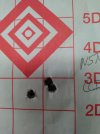 N570 CCI BR2 primer (2).jpg129.2 KB · Views: 128
N570 CCI BR2 primer (2).jpg129.2 KB · Views: 128 -
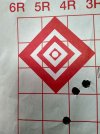 N570 CCI 250 Magnum Primer Wind WLRM similar (2).jpg199.1 KB · Views: 126
N570 CCI 250 Magnum Primer Wind WLRM similar (2).jpg199.1 KB · Views: 126 -
 N570 Fed 210M primer (2).jpg115.3 KB · Views: 146
N570 Fed 210M primer (2).jpg115.3 KB · Views: 146 -
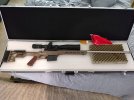 Savage 100 Shilen Barrel 300 PRC (2).jpg170.5 KB · Views: 164
Savage 100 Shilen Barrel 300 PRC (2).jpg170.5 KB · Views: 164 -
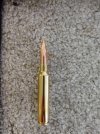 300 PRC 220 Lapua (2).jpg271.1 KB · Views: 154
300 PRC 220 Lapua (2).jpg271.1 KB · Views: 154 -
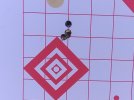 IMG_20211115_103853480 (2).jpg93.2 KB · Views: 150
IMG_20211115_103853480 (2).jpg93.2 KB · Views: 150
